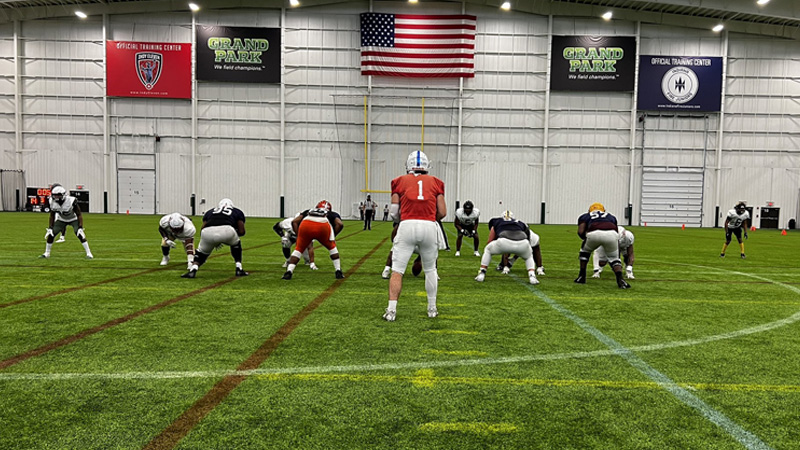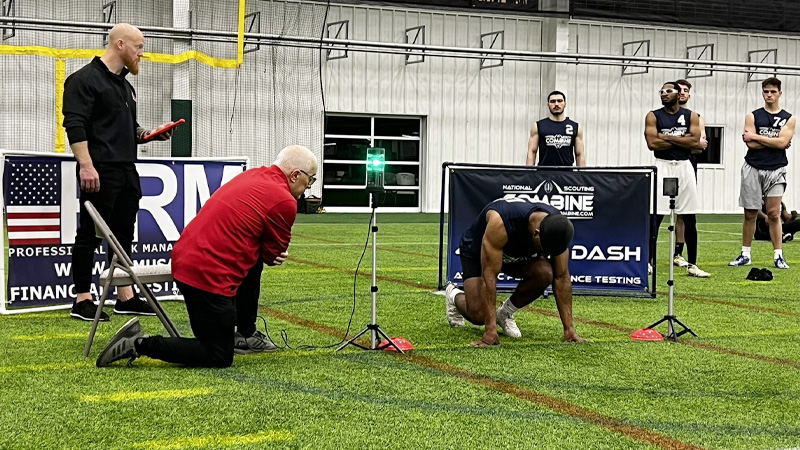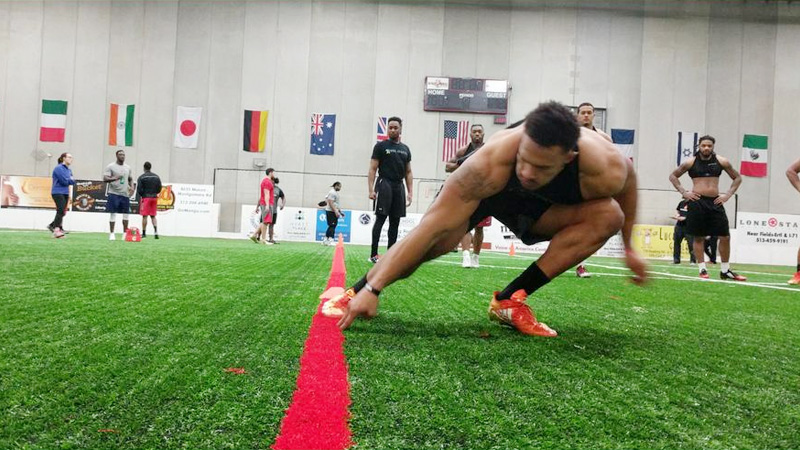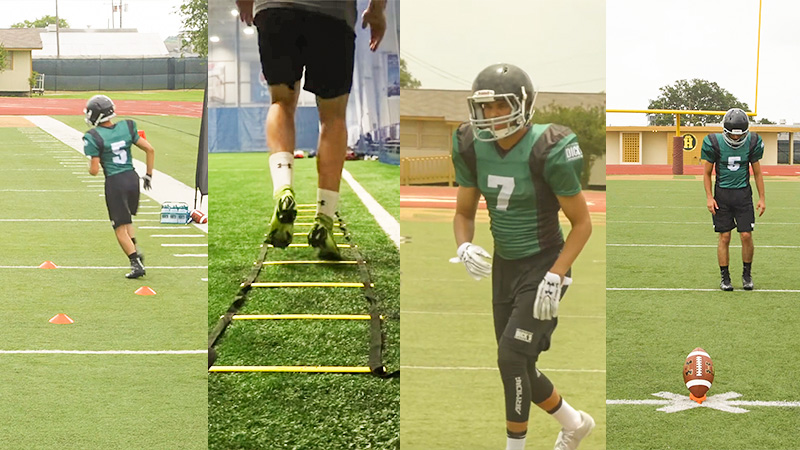In the high-paced and physically demanding sport of football, agility, speed, and footwork are critical attributes that can make all the difference between success and defeat on the field.
To excel in this sport, players must possess the ability to swiftly change direction, accelerate, decelerate, and manoeuvre with precision.
Football agility, speed, and footwork drills play a crucial role in developing these essential skills.
Coaches and athletes alike recognize the importance of honing these attributes, and a well-rounded list of drills designed to enhance agility, speed, and footwork is an invaluable resource for any football training regimen.
From cone agility drills that challenge lateral movements to ladder speed drills that improve coordination, these exercises aim to transform athletes into agile and agile performers ready to face the dynamic challenges of the game.
Let’s discuss the football agility, speed, and footwork drills list.
Football Agility, Speed, and Footwork Drills List
Here is a list of some football agility, speed, and footwork drills with a brief description of each one:
Karaoke
This drill improves your lateral movement and coordination by having you run sideways and cross your feet in front and behind each other. You can use a ladder or cones to mark the distance and direction of the drill.
Circle-Around-The-Cone
This drill enhances your acceleration and deceleration by having you run around a cone with quick steps and then sprint to another cone. You can vary the distance and angle of the cones to challenge yourself.
Fast Feet Drill
This drill boosts your agility and footwork by having you sprint to a cone, backpedal to another cone, and then sprint again. You can add more cones and change the direction of the drill to make it more difficult.
Weave and Zig-Zag
These drills improve your ability to change direction and avoid defenders by having you weave in and out of a line of cones. In a weave drill, you backpedal before passing each cone, while in a zig-zag drill, you just run from one cone to the next.
Four-Cone Box
This drill develops your speed and agility in different directions by having you sprint, shuffle, backpedal, and turn around a square of cones. You can increase the size of the square and the number of repetitions to challenge yourself.
Speed Ladder Change-of-Direction
This drill improves your foot speed and quickness by having you go through a ladder as fast as possible, both sideways and backward, before breaking into a sprint. You can vary the pattern and tempo of the ladder to challenge yourself.
Left-to-Right Jumps
This drill enhances your explosive power and balance by having you jump on one leg from side to side over small hurdles. You can increase the height and number of hurdles to challenge yourself.
Single-Leg Ball Squats
This drill strengthens your legs and core by having you perform a squat on one leg while holding an exercise ball against a wall.
You can increase the weight of the ball and the depth of the squat to challenge yourself.
Single-Leg Band Jumps
This drill increases your explosive power and symmetry by having you perform a one-leg squat while holding an exercise band before jumping as high as possible.
You can increase the resistance of the band and the number of repetitions to challenge yourself.
Jump Rope
This drill improves your coordination, endurance, and footwork by having you jump over a rope with different patterns and speeds. You can vary the length and type of the rope to challenge yourself.
What Is An Agility Drill In Football?

An agility drill in football is a specific training exercise designed to improve a player’s ability to change direction rapidly, accelerate, decelerate, and maneuver with quick, precise movements on the field.
Agility is a fundamental skill that enables players to evade defenders, create separation, and react swiftly to game situations.
These drills typically involve a combination of lateral movements, quick turns, and dynamic footwork patterns. For example, the cone agility drill requires players to weave in and out of cones, testing their ability to change direction quickly and maintain balance.
Another popular agility exercise is the ladder speed drill, where players perform various footwork patterns through an agility ladder on the ground, enhancing their coordination and quickness.
Agility drills are an essential part of football training programs as they not only improve physical attributes but also enhance a player’s ability to make split-second decisions and perform at peak levels during competitive games.
How Can I Improve My Agility And Speed In Football?

Agility and speed are two essential skills for football players, as they allow them to move quickly, change direction, and create space on the field.
There are many ways to improve your agility and speed in football, but here are some of the most effective ones:
Perform Agility Drills
Agility drills are exercises that focus on developing your ability to move quickly and change direction with ease.
They can help you improve your footwork, coordination, balance, and overall agility, which are critical for football.
Some examples of agility drills for football are karaoke, circle-around-the-cone, fast feet drill, weave and zig-zag, four-cone box, speed ladder change-of-direction, and left-to-right jumps.
You can perform these drills with or without a ball, depending on your level of skill and difficulty.
Do Plyometrics
Plyometrics are exercises that involve explosive movements that generate power and speed. They can help you improve your jump height, acceleration, and reaction time, which are important for football.
Some examples of plyometric exercises for football are box jumps, tuck jumps, single-leg ball squats, single-leg band jumps, and depth jumps. You can do these exercises with or without weights, depending on your level of strength and difficulty.
Do Resistance Training
Resistance training is a type of exercise that involves using weights or bands to create tension and challenge your muscles. It can help you improve your strength, endurance, and muscle mass, which are essential for football.
Some examples of resistance training exercises for football are squats, lunges, deadlifts, bench presses, rows, and pull-ups. You can do these exercises with different types of weights or bands, depending on your level of fitness and difficulty.
Do Sprint Intervals
Sprint intervals are a type of exercise that involves alternating between short bursts of high-intensity running and longer periods of low-intensity recovery.
They can help you improve your cardiovascular fitness, anaerobic capacity, and metabolic rate, which are beneficial for football. Some examples of sprint interval exercises for football are shuttle runs, hill sprints, sprint ladders, and fartlek runs.
You can do these exercises with different distances and durations, depending on your level of stamina and difficulty.
These are some of the best ways to improve your agility and speed in football. By doing these exercises regularly and consistently, you can enhance your performance and skills on the field.
What Are 5 Agility Exercises?

Agility exercises are a type of training that improves your ability to move quickly and change direction with ease.
They can help you enhance your performance in sports, fitness, and everyday activities. Some of the benefits of agility exercises are:
- They improve your balance, coordination, and body awareness.
- They increase your speed, power, and reaction time.
- They reduce your risk of injury and improve your mobility.
- They challenge your cardiovascular system and burn calories.
Here are five agility exercises that you can try at home or at the gym:
Lateral Plyometric Jumps
This exercise improves your explosive power, balance, and coordination by having you jump from side to side over a small object, such as a cone or a box. You can increase the height and distance of the jumps to challenge yourself.
Speed Ladder Drills
This exercise improves your foot speed and quickness by having you go through a ladder as fast as possible, using different patterns and directions. You can vary the tempo and complexity of the ladder to challenge yourself.
Box Jumps
This exercise improves your leg strength and power by having you jump onto a box or a platform from a standing position. You can increase the height and number of the jumps to challenge yourself.
Lateral Jumps
This exercise improves your lateral movement and agility by having you jump over a line or a rope from side to side. You can increase the speed and number of the jumps to challenge yourself.
Tuck Jumps
This exercise improves your explosive power and endurance by having you jump as high as possible and bring your knees to your chest. You can increase the intensity and number of the jumps to challenge yourself.
I hope this helps you learn more about agility exercises and how they can benefit you.
FAQ
What are football agility, speed, and footwork drills?
Football agility, speed, and footwork drills are specific exercises designed to enhance a player’s ability to change direction rapidly, accelerate, decelerate, and manoeuvre with precision on the football field.
Why are agility, speed, and footwork essential in football?
Agility, speed, and footwork are crucial in football as they enable players to evade defenders, create separation, and respond quickly to changing game situations.
Players with superior agility and footwork can outmaneuver opponents, while speed allows them to cover ground quickly and capitalize on scoring opportunities.
What are some common football agility drills?
Common football agility drills include cone drills, ladder drills, shuttle runs, and T-drills. These drills challenge players to perform quick changes of direction, lateral movements, and acceleration, improving their agility and ability to navigate the field effectively.
How do speed drills benefit football players?
Speed drills help football players develop greater acceleration and top-end speed. By incorporating sprint training, plyometric exercises, and interval workouts, players can increase their speed, allowing them to chase down opponents, break away from defenders, and be more explosive on the field.
Can footwork drills enhance a player’s performance in specific positions?
Yes, footwork drills can be tailored to benefit players in specific positions. For example, defensive backs can benefit from mirror drills that improve their ability to stay close to offensive players, while linemen can focus on agility drills to improve their quickness and reaction time during plays.
Conclusion
In the realm of football, the mastery of agility, speed, and footwork remains a cornerstone of excellence on the field.
The comprehensive list of drills designed specifically to enhance these attributes showcases the dedicated efforts of coaches and players in their pursuit of peak performance.
By incorporating cone agility drills, ladder speed exercises, plyometric workouts, and more, football athletes continually refine their ability to swiftly change direction, accelerate, and navigate the demands of the game with finesse.
As these players dedicate themselves to the art of footwork and mobility, they become dynamic, agile performers, well-equipped to make decisive plays and emerge victorious on the field.
With a collection of agility, speed, and footwork drills at their disposal, football athletes forge a path toward greatness, exemplifying the true essence of skill and athleticism in this beloved sport.







